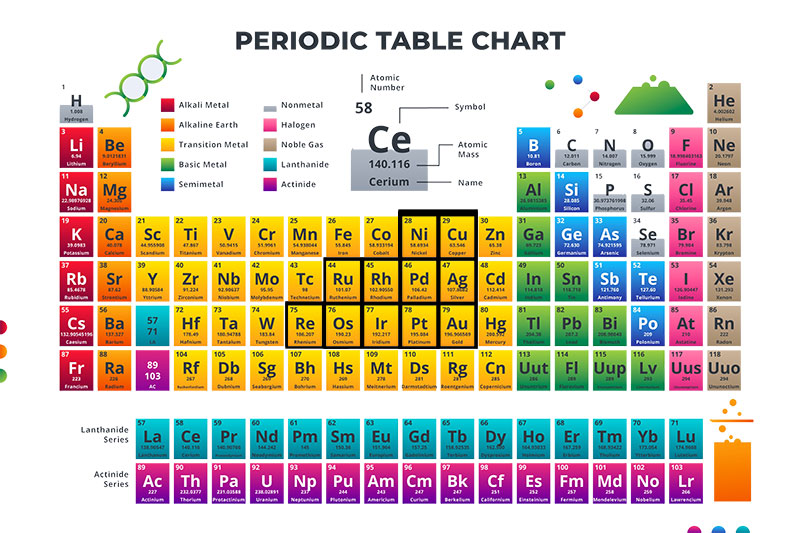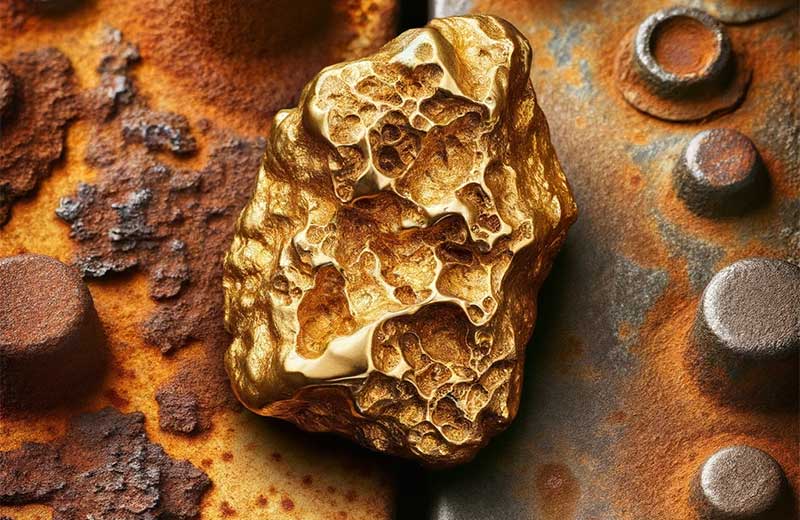People have always loved gold. This precious metal symbolizes wealth and luxury across the globe.
Gold’s malleability makes it perfect for jewelry and coins. This soft metal shapes easily into beautiful forms.
Many people wonder: does gold rust? Discover the science behind gold’s unique properties here.
| Key Insights |
|---|
| Gold does not rust, because it doesn’t contain iron. |
| Gold is considered a Noble Metal and like other noble metals, it doesn’t react or mix easily with other substances. |
| Mixing gold with other metals like silver and copper may cause the gold to tarnish. |
| Maintaining gold items through proper care, such as avoiding chemicals and using gentle cleaning methods, can prevent tarnishing and preserve their luster. |

Start buying precious metals at cost.
Understanding Gold
Gold stands out in the world of metals. Its unique chemical properties make it resistant to many issues that plague common metals.
Unlike metals like iron, which undergo chemical reactions when exposed to moisture and air, gold remains largely unaffected. This non reactive quality is one reason gold has been so highly valued throughout history.
Pure gold belongs to the group of precious metals. These metals resist corrosion and tarnishing better than base metals.
Does Gold Rust?
When we talk about rust, we’re referring to iron oxide. This reddish-brown compound forms when iron reacts with oxygen and moisture.
Rust is a form of corrosion. Corrosion causes irreversible damage to material due to chemical reactions.
Since gold doesn’t contain iron, it doesn’t rust. Pure gold remains completely rust-free under normal conditions.
You need to differentiate between pure gold and its alloys. While pure gold stays rust-free, gold alloys might be susceptible to some form of corrosion depending on the other metals they contain.
Gold and Other Forms of Corrosion
While gold doesn’t rust, it can face other forms of corrosion when alloyed with different metals. Tarnish is a thin layer of corrosion that forms on certain metals due to their reaction with oxygen.
Metals like silver and copper are prone to tarnishing. Gold jewelry that contains these base metals can show signs of tarnish over time.
The tarnishing process is usually superficial. You can reverse tarnishing in many cases with proper cleaning methods.
Gold tarnish appears as discoloration on the surface. This happens when the underlying metal in gold alloys reacts with air and moisture.
Gold Alloys and Their Susceptibility
Pure gold is a soft metal. To enhance its strength for jewelry and coins, manufacturers alloy it with other metals like copper, silver, or palladium.
These gold alloys provide strength but can make the gold more susceptible to tarnishing. Gold bars made from pure gold resist tarnish better than alloyed pieces.
For example, 14-carat gold jewelry contains about 58.3% gold. It might tarnish faster than 18-carat pieces, which contain 75% pure gold.
The more base metals in the alloy, the higher the chance of tarnish. Gold coins with lower purity face more tarnishing than those with higher gold content.
Caring for Gold Items
Gold items, especially jewelry, require care to maintain their luster and prevent tarnishing.
Here are some tips:
- Avoid exposing gold to chemicals like perfumes or cleaning agents
- Remove gold jewelry when washing hands or showering
- Store gold items separately to prevent scratches
- Use a soft cloth to clean gold items gently
Proper storage helps prevent tarnishing. Keep your gold jewelry in a dry place with a silica gel packet to absorb moisture.

Start buying precious metals at cost.
Gold’s Interaction with Other Elements
Gold is known as a Noble Metal. Think of noble metals as the aristocrats of the metal world – they don’t like to mix or react easily with other substances.
This quality makes gold, platinum, and palladium resistant to tarnishing and corrosion.
When gold is combined with reactive elements like copper or silver, it becomes more reactive.
If gold is mixed with copper, it might start to tarnish when exposed to certain chemicals in air. The copper in the mix is reacting, not the actual gold itself.
Many metals react with oxygen to create corrosion. Gold’s resistance to these chemical reactions makes it valuable among precious metals.
The elements with the black background below are typically considered to be Noble Metals.

Other Noble Metals
Commonly, gold, platinum, and platinum group metals like ruthenium, rhodium, palladium, osmium, and iridium are classified as noble. This varies by field.
In physics, only copper, silver, and gold are considered noble metals. Dentistry may avoid gold to prevent reactions in the mouth.
In a broader chemical context, the list can include elements like mercury. What is considered a “noble metal” changes based on specific criteria and context.
These metals share similar properties in preventing rust and tarnish compared to base metals like steel and aluminum.
The Fundamental Stability of Gold
At the atomic level, gold is less reactive than many metals. It doesn’t easily lose or gain electrons, making it stable and resistant to chemical reactions.
This stability explains why gold doesn’t corrode like iron or tarnish like silver coins. It’s also why gold has been used for centuries in various applications.
Gold means reliability in both jewelry and electronics. Its resistance to corrosion makes it perfect for sensitive electronic components.
Gold in Everyday Life
Gold’s resistance to corrosion and excellent conductivity make it valuable in modern applications. Gold is used in electronics because it doesn’t corrode, ensuring devices function reliably.
Gold coins and gold bullion are popular among investors as a hedge against economic instability. This stems from gold’s enduring value and stability.
Gold bars offer investors a way to own precious metals without worrying about rust or tarnish. Unlike other metals, gold maintains its value over time.
Cleaning and Caring for Tarnished Gold
If your gold jewelry or items show signs of tarnish, don’t fret. Here’s how you can restore their shine:
- Mix a few drops of mild dish soap with warm water.
- Soak the gold item in this solution for about 15 minutes.
- Gently scrub the item with a soft cloth or a soft-bristle brush.
- Rinse with warm water and air dry.
For more stubborn tarnish, a paste of baking soda and water can be used. However, always test a small, inconspicuous area first to ensure it doesn’t damage the item.
Gold’s Place in the World of Metals
In the grand scheme of metals, gold holds a special place. Its unique properties, combined with its rich history, make it one of the most sought-after metals.
While it doesn’t rust or tarnish easily, understanding how to care for gold and its alloys keeps your gold items pristine. Whether you’re preventing rust on gold bullion or cleaning gold jewelry, proper care matters.
Gold’s resistance to rust and tarnish sets it apart from different metals. This quality, combined with its beauty, explains why civilizations have treasured it for millennia.
The contrast between gold and common metals like iron is clear. While iron forms rust through oxidation, gold remains unchanged when exposed to oxygen and moisture.
Real gold doesn’t show signs of rusting under normal conditions. If you see rust on a gold item, it likely contains significant amounts of base metal or isn’t actually gold.

Start buying precious metals at cost.
FAQs
Gold, being one of the precious metals, doesn’t rust in water. However, if the gold is alloyed with other metals, those metals might react with water or other chemicals, leading to discoloration.
Rust is a reddish-brown compound that forms on iron or iron alloys. Tarnish, often seen on silver coins, is a thin layer of discoloration that forms on metals. If a gold item shows signs of discoloration, it’s more likely to be tarnish than rust.
Real gold doesn’t rust. If an item labeled as gold shows signs of rust, it’s likely not actual gold. Other methods include the hallmark test, magnet test, and professional appraisal.
Pure gold is a soft metal. To increase its strength and durability, especially for jewelry, it’s alloyed with metals like copper, silver, or nickel.
While gold is highly resistant to corrosion, in very rare and specific chemical environments, it might corrode. However, such conditions are uncommon and not encountered in everyday life.
Platinum and palladium are two metals that, like gold, are resistant to corrosion and tarnishing.
Tarnishing can occur on gold alloys, especially those with metals like copper or silver. Pure gold doesn’t tarnish, so if your gold jewelry tarnishes, it might indicate the presence of other metals in the alloy. Cleaning tarnished gold can restore its original luster.
Silver coins, unlike gold, are more reactive and can tarnish more quickly when exposed to certain environmental factors. Gold’s resistance to tarnish is one of the reasons it’s valued among precious metals.
To clean tarnished gold and restore its shine, a gentle cleaning solution can be used. It’s essential to ensure the method is suitable for gold and won’t affect any underlying metal in an alloyed item
Gold bars, renowned among precious metals, are notably resistant to tarnish. However, if alloyed, the underlying metal might influence its tarnish resistance, leading to subtle gold tarnish over time.
To rejuvenate tarnished gold, a mild cleaning solution is advised. It’s crucial to ensure the cleaning method is gold-friendly and doesn’t compromise any underlying metal in alloyed pieces.
